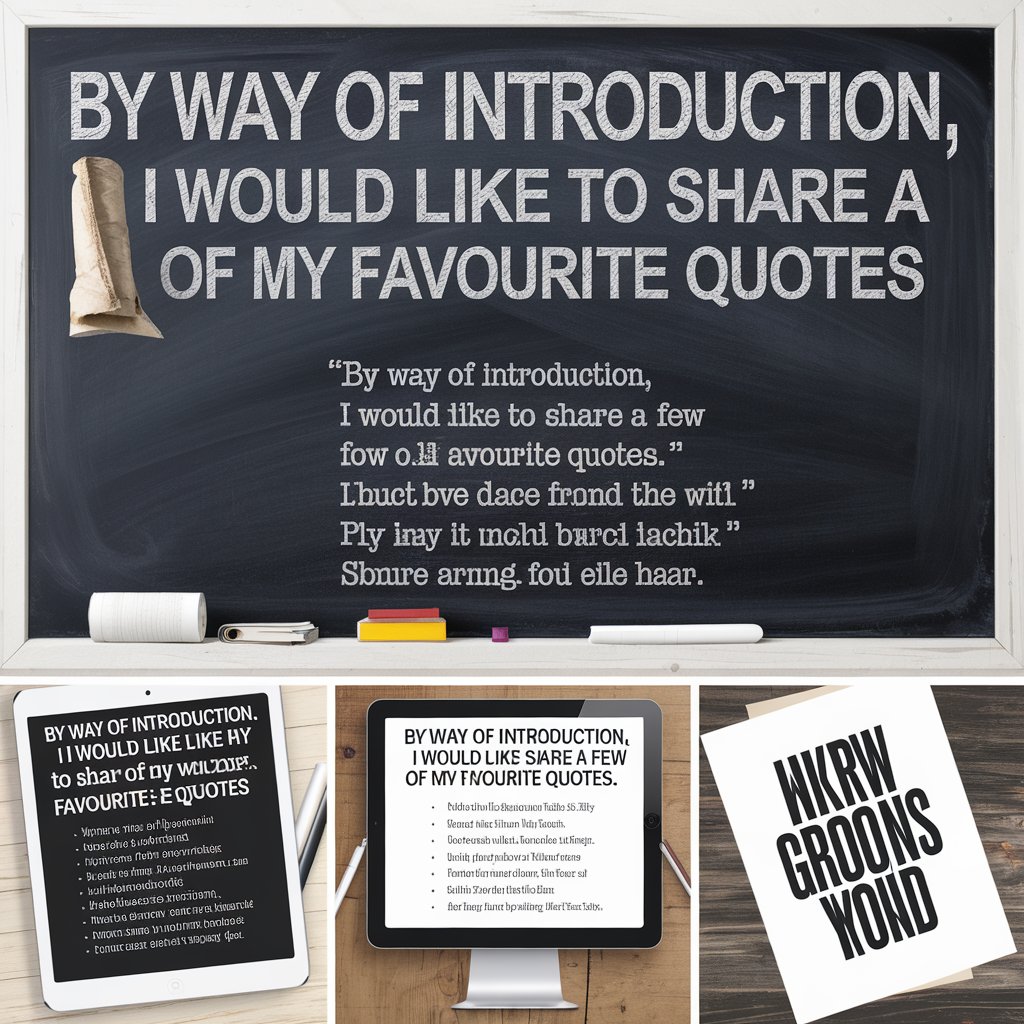Introduction
When crafting emails, particularly in professional settings, how you introduce yourself or your topic can significantly impact the reader’s perception. Using phrases like “by way of introduction” can sometimes feel stale or overly formal.
In this article, we will explore 15 alternatives to “by way of introduction” in emails that can enhance your communication. Choosing the right phrase not only sets the tone for your message but also showcases your personality and professionalism.
like more : 15 New Ways to Say “Have a Great Rest of Your Week” – Grammar Beacon
Importance of Effective Email Introductions
Effective email introductions are crucial. They establish rapport, convey your intent, and provide context for your message. A strong introduction can make the recipient more inclined to engage with your email, whether it’s for networking, job applications, or client communications.
Why Word Choice Matters
Your choice of words can either invite conversation or create barriers. Phrases that resonate with the reader can foster a sense of connection. This article focuses on 15 alternatives to “by way of introduction” to help you articulate your thoughts more effectively.

Alternative Phrases for Introductions
1. Allow Me to Introduce Myself
This phrase is polite and sets a formal tone. It works well in various professional contexts.
Example Email:
Subject: Introduction
Hi Sarah,
Allow me to introduce myself—my name is Mark Johnson, and I’m the new marketing manager at XYZ Corp. I look forward to collaborating with you on upcoming projects!
Best,
Mark
2. I’d Like to Introduce Myself
Slightly more casual, this phrase conveys warmth and friendliness.
Example Email:
Subject: Nice to Meet You!
Hi Tom,
I’d like to introduce myself. I’m Lisa, the new sales associate at ABC Industries. I’m eager to connect and learn from your experience!
Warm regards,
Lisa
3. Pleased to Meet You
A classic phrase, this option fits both formal and informal contexts, making it versatile.
Example Email:
Subject: Quick Introduction
Dear Mr. Smith,
Pleased to meet you via email. I’m John, a software developer at Tech Solutions, and I’m excited to discuss our collaboration.
Sincerely,
John
4. Let Me Start by Introducing Myself
This phrase allows for a smooth transition into your self-introduction, making it feel natural.
Example Email:
Subject: Introduction
Hello Emily,
Let me start by introducing myself. I’m Rebecca, your new project coordinator. I look forward to working together!
Best wishes,
Rebecca
5. I’m Excited to Connect with You
An upbeat phrase that shows enthusiasm and can make you more approachable.
Example Email:
Subject: Excited to Connect!
Hi David,
I’m excited to connect with you! I’m Mark, the new graphic designer at Creative Agency. Can’t wait to share ideas!
Cheers,
Mark
6. As a Brief Introduction
This phrase sets the stage for a succinct overview of who you are, perfect for busy recipients.
Example Email:
Subject: Quick Intro
Hi Jennifer,
As a brief introduction, I’m James, the new business analyst at Innovative Solutions. I look forward to learning from you!
Best,
James
7. Before We Dive In, Let Me Introduce Myself
This phrase is conversational and can work well in more relaxed environments.
Example Email:
Subject: Let’s Get Started!
Hi Anna,
Before we dive in, let me introduce myself. I’m Sarah, the new account manager. Excited to start our collaboration!
Take care,
Sarah
8. I’m New Around Here
This casual and relatable phrase works well in friendly workplaces or when addressing a team.
Example Email:
Subject: Greetings from the Newbie
Hello Team,
I’m new around here—my name is Alex, and I just joined the finance department. Looking forward to meeting everyone!
Cheers,
Alex

9. Greetings and Introductions
A straightforward phrase, this option is effective for formal emails.
Example Email:
Subject: Greetings!
Dear Ms. Williams,
Greetings and introductions! I’m Nancy, the new HR manager at Global Corp. I’m excited to support our team.
Warm regards,
Nancy
like more : 25 Phrases Similar to Be There or Be Square Synonyms – Grammar Beacon
10. It’s My Pleasure to Introduce Myself
This polite phrase emphasizes eagerness to engage with the recipient.
Example Email:
Subject: Introduction
Hi Mark,
It’s my pleasure to introduce myself. I’m Julia, the new software engineer. Looking forward to our upcoming project!
Best wishes,
Julia
Final Thoughts
Choosing the Right Introduction Phrase
Selecting the appropriate introduction phrase can have a significant impact on how your message is received. By utilizing these 15 alternatives to “by way of introduction,” you can enhance your emails, foster connections, and create a lasting impression.
Perfect Email Introductions: 11 Examples for Any Scenario
What is a Self-Introduction Email?
A self-introduction email serves to inform the recipient about your background, role, or intent. It’s often the first step in establishing professional connections and can lead to fruitful discussions.

Formal Email Introduction Examples
Job Application Email Template
Subject: Application for Marketing Manager Position
Dear Hiring Manager,
I’m writing to introduce myself as a candidate for the Marketing Manager position at your esteemed company. My name is Tom, and I bring over five years of experience in digital marketing.
Looking forward to the opportunity.
Best,
Tom
Open Position Inquiry
Subject: Inquiry About Open Positions
Hi Sarah,
I’d like to inquire about any open positions in your team. My name is Kelly, and I’m an experienced project manager seeking new challenges.
Thank you!
Kelly
Information Request
Subject: Request for Information
Dear Mr. Brown,
Allow me to introduce myself. I’m Lisa, a researcher at XYZ University. I’m seeking information regarding your recent study on environmental impacts.
Best regards,
Lisa
Professional Introduction
Subject: Introduction to New Colleague
Hi Team,
I’m pleased to introduce my colleague, Rachel. She will be joining us as a product manager next week, and I’m sure she will bring great insights to our projects.
Looking forward to working together!
James
Self-introduction Email Sample
Subject: Introduction
Hello Everyone,
I’m excited to introduce myself. My name is Jason, and I just joined the team as a software engineer. I’m eager to contribute to our projects.
Cheers,
Jason
Formal Email Pitch
Subject: Proposal for Collaboration
Dear Ms. Taylor,
Let me start by introducing myself. I’m Emily, and I represent Innovative Solutions. We specialize in tech-driven marketing strategies that could benefit your organization.
Best,
Emily
Networking Email
Subject: Networking Opportunity
Hi John,
I’m reaching out to connect. My name is Amy, and I work in digital marketing. I’d love to discuss potential collaboration opportunities in the near future.
Warm regards,
Amy
Sales Introduction Email
Subject: Introduction to Our Services
Dear Mr. Harris,
I’m writing to introduce our company, ABC Solutions. We offer innovative software solutions tailored to your needs and would love to discuss how we can assist you.
Looking forward to connecting,
Rachel

Company Introduction Email
Subject: Introduction to Our Company
Hi Team,
It’s my pleasure to introduce our company, XYZ Corp. We specialize in high-quality manufacturing solutions and look forward to contributing to your projects.
Best,
Tom
New Employee Self-introduction
Subject: Meet Our New Team Member
Dear All,
I’m excited to introduce our new colleague, Sam. He joins us as a marketing associate and brings valuable experience that will be beneficial to our team.
Best wishes,
Karen
Newsletter Introduction Examples
Subject: Welcome to Our Monthly Newsletter
Hi Everyone,
I’d like to introduce our monthly newsletter. We aim to provide insights and updates about our industry, along with helpful tips for your projects.
Cheers,
Michael
How to Write an Introduction Email
Key Elements to Include
- Subject Line: Keep it clear and concise, reflecting the email’s purpose.
- Greeting: Address the recipient appropriately, setting the tone for the message.
- Introduction: Clearly state who you are and your purpose for reaching out.
- Body: Provide relevant details and context to inform the reader.
- Closing: End with a call to action or polite closing.
Tips for Crafting Your Email
- Be concise: Get to the point quickly to respect the recipient’s time.
- Use a friendly tone: Keep it warm and approachable to encourage engagement.
- Proofread: Avoid typos and grammatical errors to maintain professionalism.
Key Takeaways
- Recap of Effective Introduction Strategies:
- Use varied phrases to keep your introductions fresh and engaging.
- Tailor your language to fit the context and audience for better connections.
- Always aim for clarity and engagement in your communication.
15 Other Ways to Say “By Way of Introduction” in an Email
Main Points
- Importance of Variety in Language: Using different phrases can enhance communication and prevent monotony. Choosing the right words helps to convey your message clearly and keeps the recipient interested.
Preliminary Greeting Options
- Crafting an Engaging Opening: Start with a friendly yet professional greeting to set the tone for the rest of your email.
Informal Introductions
- Casual Yet Professional Alternatives: Use lighter phrases for a more relaxed atmosphere, especially in informal settings or with familiar colleagues.
Polite Email Openings
Formal Options for Professional Settings:
Choose more sophisticated language when the situation demands it, ensuring respect and professionalism.
like to read more : 25 Other Ways to Say “Happy Birthday in Advance” – Grammar Beacon

Casual Exchange Phrases
- Friendly Approaches for Informal Emails: Keep it approachable in less formal contexts, making the conversation feel more personal.
Grammatically Correct Phrasing
- Ensuring Clarity and Professionalism: Maintaining proper grammar enhances your credibility and helps avoid misunderstandings.
Formal Introductory Language
- When to Use More Formal Language: Understand your audience to choose appropriate tones and phrases based on the context of your email.
Common Misuses to Avoid
- Mistakes to Watch Out For: Be cautious of overcomplicating your introductions or using jargon that might confuse the reader.
Suitable Contexts for Usage
- Identifying Appropriate Scenarios: Know when to be formal or casual based on your relationship with the recipient and the nature of the communication.
Varying Phrasing Examples
- Expanding Your Email Vocabulary: Incorporate new phrases into your writing to keep your communication dynamic and engaging.
Alternative Usage Scenarios
- Different Contexts for Introductions: Adapt your language based on the specific situation or the nature of your message to maintain relevance.
Formal Client Communication
- Maintaining Professionalism with Clients: Use formal phrases when addressing clients to convey respect and professionalism, reinforcing your commitment to quality service.
Colleague Interaction Styles
- Tailoring Your Message for Peers: Adjust your tone and phrasing based on familiarity with colleagues, allowing for more casual exchanges when appropriate.
Conclusion
The Power of a Well-Structured Introduction
Crafting an effective introduction is a valuable skill in email communication. By utilizing these 15 alternatives to “by way of introduction,” you can enhance your messages, foster connections,
and create a lasting impression. Your word choice not only reflects your professionalism but also helps in establishing rapport. Remember, in the world of email, how you introduce yourself can open doors to new opportunities and collaborations.

Steve Rogars is an experienced blogger and language enthusiast at Grammar Beacon. With a passion for clear communication and a keen eye for detail, he shares insights on grammar, writing tips, and language trends. Steve’s engaging style makes learning enjoyable, helping readers enhance their writing skills. When he’s not crafting posts, he enjoys reading, exploring new cultures, and inspiring others to appreciate the beauty of language.







